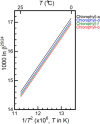Theoretical isotopic fractionation of magnesium between chlorophylls
- PMID: 28765587
- PMCID: PMC5539320
- DOI: 10.1038/s41598-017-07305-6
Theoretical isotopic fractionation of magnesium between chlorophylls
Abstract
Magnesium is the metal at the center of all types of chlorophyll and is thus crucial to photosynthesis. When an element is involved in a biosynthetic pathway its isotopes are fractionated based on the difference of vibrational frequency between the different molecules. With the technical advance of multi-collectors plasma-mass-spectrometry and improvement in analytical precision, it has recently been found that two types of chlorophylls (a and b) are isotopically distinct. These results have very significant implications with regards to the use of Mg isotopes to understand the biosynthesis of chlorophyll. Here we present theoretical constraints on the origin of these isotopic fractionations through ab initio calculations. We present the fractionation factor for chlorphyll a, b, d, and f. We show that the natural isotopic variations among chlorophyll a and b are well explained by isotopic fractionation under equilibrium, which implies exchanges of Mg during the chlorophyll cycle. We predict that chlorophyll d and f should be isotopically fractionated compared to chlorophyll a and that this could be used in the future to understand the biosynthesis of these molecules.
Conflict of interest statement
The authors declare that they have no competing interests.
Figures
Similar articles
-
Hydrogen, carbon and nitrogen isotopic fractionations during chlorophyll biosynthesis in C3 higher plants.Phytochemistry. 2005 Apr;66(8):911-20. doi: 10.1016/j.phytochem.2005.03.004. Phytochemistry. 2005. PMID: 15845409
-
Magnesium-Isotope Fractionation in Chlorophyll-a Extracted from Two Plants with Different Pathways of Carbon Fixation (C3, C4).Molecules. 2020 Apr 3;25(7):1644. doi: 10.3390/molecules25071644. Molecules. 2020. PMID: 32260083 Free PMC article.
-
Magnesium-isotope fractionation during plant growth.Environ Sci Technol. 2008 Nov 1;42(21):7831-6. doi: 10.1021/es8012722. Environ Sci Technol. 2008. PMID: 19031868
-
Chlorophyll modifications and their spectral extension in oxygenic photosynthesis.Annu Rev Biochem. 2014;83:317-40. doi: 10.1146/annurev-biochem-072711-162943. Epub 2014 Mar 12. Annu Rev Biochem. 2014. PMID: 24635479 Review.
-
Recent overview of the Mg branch of the tetrapyrrole biosynthesis leading to chlorophylls.Photosynth Res. 2008 May;96(2):121-43. doi: 10.1007/s11120-008-9291-4. Epub 2008 Feb 14. Photosynth Res. 2008. PMID: 18273690 Review.
Cited by
-
Coapplication of Effective Microorganisms and Nanomagnesium Boosts the Agronomic, Physio-Biochemical, Osmolytes, and Antioxidants Defenses Against Salt Stress in Ipomoea batatas.Front Plant Sci. 2022 Jul 13;13:883274. doi: 10.3389/fpls.2022.883274. eCollection 2022. Front Plant Sci. 2022. PMID: 35909720 Free PMC article.
-
Effects of SNP, MgSO4, and MgO-NPs foliar application on Spinacia oleracea L. growth and physio-biochemical responses under cadmium stress.Sci Rep. 2024 Nov 4;14(1):26687. doi: 10.1038/s41598-024-77221-z. Sci Rep. 2024. PMID: 39496661 Free PMC article.
-
Stable Isotope Fractionation of Metals and Metalloids in Plants: A Review.Front Plant Sci. 2022 Apr 19;13:840941. doi: 10.3389/fpls.2022.840941. eCollection 2022. Front Plant Sci. 2022. PMID: 35519812 Free PMC article. Review.
-
Isotope metallomics approaches for medical research.Cell Mol Life Sci. 2020 Sep;77(17):3293-3309. doi: 10.1007/s00018-020-03484-0. Epub 2020 Mar 4. Cell Mol Life Sci. 2020. PMID: 32130428 Free PMC article. Review.
-
MgONPs Can Boost Plant Growth: Evidence from Increased Seedling Growth, Morpho-Physiological Activities, and Mg Uptake in Tobacco (Nicotiana tabacum L.).Molecules. 2018 Dec 19;23(12):3375. doi: 10.3390/molecules23123375. Molecules. 2018. PMID: 30572666 Free PMC article.
References
-
- Blankenship, R. E. Molecular Mechanisms of Photosynthesis. (Blackwell, 2002).
-
- Grimm, B., J., P. R., Rudiger, W. & H., S. Chlorophylls and Bacteriochlorophylls: Biochemistry, Biophysics, Functions, and Applications. (Springer, 2006).
-
- Viers J, et al. Evidence of Zn isotopic frationation in a soil-plant system of a pristine tropical watershed (Nsimi, Cameroon) Chem. Geol. 2007;239:124–137. doi: 10.1016/j.chemgeo.2007.01.005. - DOI
Publication types
MeSH terms
Substances
LinkOut - more resources
Full Text Sources
Other Literature Sources



